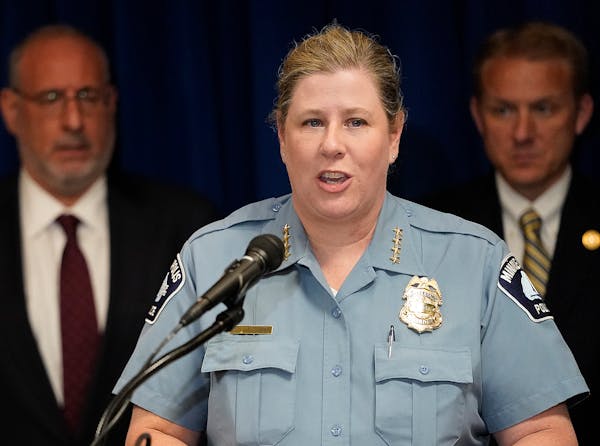Minneapolis Police Chief Brian O'Hara has loosened the department's pursuit policy to allow officers to chase fleeing suspects involved in certain firearm-related offenses, a change he says is meant to help curb rampant gun violence.
Under the new policy, a pursuit can be initiated when a person illegally discharges or points a weapon at someone — even in situations that result in no physical harm. Previous guidelines placed strict parameters on when officers could request approval to engage in a pursuit, often requiring that there be a victim.
"You could have a scenario — which has happened — where police are present and someone starts shooting a gun off in the air from a car, takes off and gets onto the highway and they can't chase," O'Hara said in an interview Friday. "That doesn't send the right message. And I don't think it meets community expectations."
The change, which went into effect May 2, carves out new exceptions for weapons offenses that O'Hara believes will provide more clarity for how officers should handle various situations. As before, authorization for any pursuit must be granted by a supervisor who will weigh the "necessity for apprehension" against the risk to officers and the public.
Minneapolis police still won't chase teens for joyriding or property crimes, for example, without an underlying threat of violence.
The policy revisions follow years of increasingly tighter restrictions on vehicle pursuits after a series of high-profiles crashes in the Twin Cities metro that elected leaders said unnecessarily put lives in danger.
Some police reform advocates questioned why O'Hara would make such a change without first consulting the community — particularly at a time when the department is seeking to rebuild trust in the midst of the Minnesota Department of Human Rights settlement agreement.
"It is not the time to be relaxing the pursuit policy," said Dave Bicking, vice president of Communities United Against Police Brutality. "This just sets us up for more tragedy."
In a 2019 case, 50-year-old Jose Angel Madrid Salcido of Minneapolis was mortally injured when an unlicensed driver fleeing a police stop smashed the car he was sitting in, pinning Salcido inside.
Later that year , MPD overhauled its pursuit policy so that officers could only give chase in situations in which they believed a suspect had committed or was about to commit "a serious and violent felony or gross misdemeanor," such as murder and attempted murder, sex crimes, kidnapping, carjacking and arson.
However, it allowed for a pursuit if the suspect's driving was "so flagrantly reckless that the driver would pose an imminent and life-threatening danger to the public if not apprehended."
Mayor Jacob Frey vowed to re-examine the policy following the 2021 death of Leneal Frazier, an innocent motorist struck and killed at a North Side intersection by a Minneapolis police officer who was chasing a carjacking suspect.
Former officer Brian Cummings was driving nearly 80 mph on residential streets when he struck Frazier's SUV at the intersection of N. Lyndale and 41st avenues. Cummings, a 14-year veteran on the force, was charged three months after the collision with second-degree manslaughter and criminal vehicular homicide. He pleaded guilty in April to criminal vehicular homicide and is expected to be sentenced June 22.
An MPD spokesman noted at the time that the pursuit was sanctioned under department policy because the driver was suspected of multiple violent felonies. But Cummings also blew through a red light, charges said, without regard for the safety of bystanders.
The crash resulted in only a minor tweak to pursuit policy language around supervisory review, according to department records.
O'Hara told the Star Tribune that he doesn't believe residents take issue with what specific crimes officers begin a pursuit over, just whether they conduct them safely.
"Whatever you're chasing somebody for, it cannot be reckless. That's the bottom line," he said, adding that officers are expected to use extreme discretion. "Just because we have a list of criteria, which may allow [you to chase] does not mean a supervisor must authorize it."
He promised to back decisions by department leaders who choose not to pursue or terminate chases they feel are unsafe.
The new policy directive contributed to last week's bust of a group of juveniles wanted in connection with a drive-by shooting that damaged the Minneapolis Public Schools administration headquarters.
Officers responded to 911 calls reporting about a dozen shots fired in the 2100 block of Girard Avenue N. on the afternoon of May 15, and gunfire pierced a café window at the Davis Center.
Surveillance footage and a Minnesota State Patrol helicopter helped track four teens who led police on a chase in a stolen Kia into south Minneapolis, occasionally hanging out of the car's windows. At some point, the minors jumped out of the car and fled on foot.
O'Hara was nearby when he heard radio traffic about the pursuit and rushed to the scene. He joined responding officers who were handcuffing one boy on the sidewalk, according to body camera footage released by the police. The 80-second video, first obtained by KSTP-TV, shows O'Hara running through an alley ahead of two subordinates and chasing down another juvenile suspect on foot.
Investigators found two firearms inside the stolen Kia. Three minors were detained, while two boys — a 14- and 15-year-old — were later charged by the Hennepin County Attorney's Office. Juvenile records for those under 16 are not public.
"These juveniles are a danger to themselves and to anyone who happens to be around them," O'Hara said in a news release hailing the arrests.
Under previous guidelines, officers would not have been permitted to engage in that chase.
Carolyn Parnell, 'trailblazer' who served as Minnesota's first IT commissioner, dies


